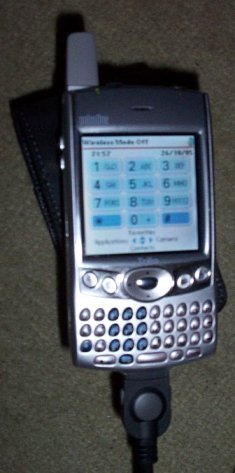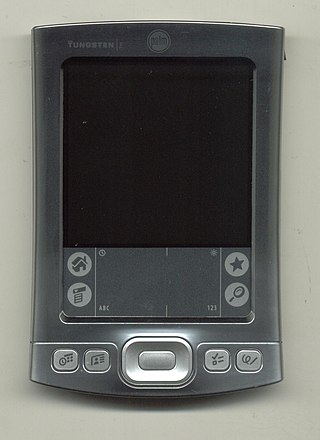
Palm OS is a discontinued mobile operating system initially developed by Palm, Inc., for personal digital assistants (PDAs) in 1996. Palm OS was designed for ease of use with a touchscreen-based graphical user interface. It was provided with a suite of basic applications for personal information management. Later versions of the OS were extended to support smartphones. The software appeared on the company's line of Palm devices while several other licensees have manufactured devices powered by Palm OS.

Palm, Inc., was an American company that specialized in manufacturing personal digital assistants (PDAs) and developing software. Palm designed the PalmPilot, the first PDA successfully marketed worldwide, and was known for the Treo 600, one of the earlier successful smartphones. Palm developed the Palm OS software for PDAs and smartphones released under its line of Palm-branded devices and also licensed to other PDA manufacturers.

Palm is a now discontinued line of personal digital assistants (PDAs) and mobile phones developed by California-based Palm, Inc., originally called Palm Computing, Inc. Palm devices are often remembered as "the first wildly popular handheld computers," responsible for ushering in the smartphone era.
The Zire Series was Palm, Inc's "consumer-grade" brand of Personal Digital Assistant.

The Tapwave Zodiac is a mobile entertainment console and personal digital assistant. Tapwave announced the system in May 2003 and began shipping in October of that same year. The Zodiac was designed to be a high-performance mobile entertainment system centered on video games, music, photos, and video for 18- to 34-year-old gamers and technology enthusiasts. By running an enhanced version of the Palm Operating System (5.2T), Zodiac also provided access to Palm's personal information management software and many other applications from the Palm developer community. The company was based in Mountain View, California.

Treo 600 was a smartphone developed by Handspring, and offered under the palmOne brand after the merger of the two companies. Released in November 2003, it has a number of integrated features and it is possible to check the calendar while talking on the phone, dial directly from contacts list, take pictures or send emails. It includes a five-way navigation button and favorites screen allowing quick access to the phone functions.

The Tungsten series was Palm, Inc.'s line of business-class Palm OS-based PDAs.
The Samsung SPH-i500 was a Palm OS-based smartphone manufactured by Samsung Electronics. It was previewed at CommunicAsia 2002 in June and launched later that year. It was later discontinued in August 2005. It was marketed in the United States for use on Sprint's mobile phone network.

The Zire 72 is Palm, Inc.'s second Personal Digital Assistant with an integrated digital camera. Introduced in 2004, it is the replacement for the Zire 71, having a 1.2 megapixel camera, 32 MB of memory, built-in Bluetooth wireless communication, video recording and playback capability, a built-in microphone, hi-res hi-color screen, SecureDigital smartcard slot, and a 312 MHz Intel PXA270 processor.

Documents To Go is BlackBerry's cross-platform office suite for Palm OS, Windows Mobile, Maemo, BlackBerry OS, Symbian, Android, and iOS. Also, a larger-screen version would have been included with the Palm Foleo, but Palm, Inc. cancelled the device before its release.

The Z22 was one of the first of Palm, Inc.'s handhelds to be released under the new "Palm" brand, and the first to be released without the "Zire" moniker. Released on October 12, 2005, it replaced the monochrome Zire 21, and was priced at $99 USD. The Palm Z22 came with Palm OS Garnet 5.4.9 preloaded and is not upgradable. It featured a 200 MHz Samsung S3C2410 ARM processor developed around the 32-bit ARM920T core that implements the ARMv4T architecture. The Z22 ran on a li-ion battery that had a life of about 8 hours depending on usage.

The Palm Treo 700p is a cell phone with advanced capabilities, commonly referred to as a smartphone. Unlike the slightly earlier Treo 700w, this model is based on Palm OS. This is the first Palm OS-based Treo model to feature high-speed cellular network support, and is also the first Treo model to support Bluetooth 1.2.

The Palm m100 series consists of four Palm OS based personal digital assistants titled m100, m105, m125, and m130. These models were intended to be "entry-level" PDAs, and therefore their cases were built from cheaper materials. Most notably, the covers of the LCD screens and the digitizers were plastic rather than glass, and the screens were smaller than the more expensive Palm devices on sale at the time.
This is a list of video game accessories that have been released for the Game Boy handheld console and its successors. Accessories add functionality that the console would otherwise not have.

The Nokia N800 Internet tablet is a wireless Internet appliance from Nokia, originally announced at the Las Vegas CES 2007 Summit in January 2007. N800 allows the user to browse the Internet and communicate using Wi-Fi networks or with mobile phone via Bluetooth. The N800 was developed as the successor to the Nokia 770. It includes FM and Internet radio, an RSS news reader, image viewer and a media player for audio and video files.
The Sony CLIÉ PEG-SJ33 was a Palm OS based handheld "Personal Entertainment Organizer" released by Sony in 2003. It was released with a heavy multimedia focus, one of its key features being the inclusion of MP3 player software and built-in stereo sound hardware. The PEG-SJ33 has the same HiRes screen as the other low-end colour CLIÉ models. This device was later superseded by the Clie TJ Series.

The Treo 90 is a Palm OS PDA developed by Handspring. It was released on May 28, 2002. The Treo 90 was the only Treo model produced without an integrated cellular phone. When first released it was the smallest Palm OS device on the market.
Handspring, Inc., was an American electronics company founded in 1998 by the founders of Palm, Inc., after they became dissatisfied with the company's direction under the new owner 3Com. The company developed Palm OS–based Visor- and Treo-branded personal digital assistants. In 2003, the company merged with Palm, Inc.'s hardware division.
The Sony Clie TJ series were mid-range personal digital assistants produced by Sony, running the Palm operating system.














